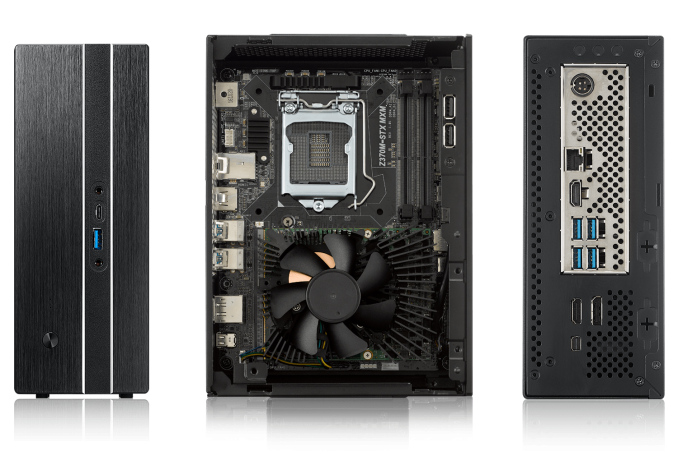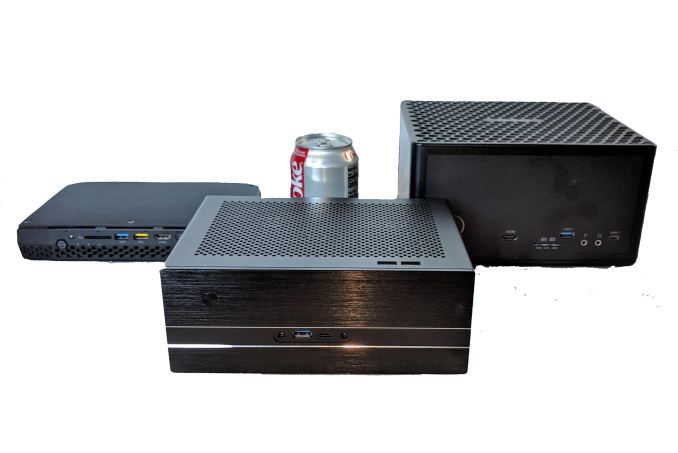ASRock DeskMini Z370 GTX1060 Review: A Compact Coffee Lake Gaming PC
by Ganesh T S on June 12, 2018 10:00 AM ESTConcluding Remarks
Our evaluation shows that the ASRock DeskMini Z370 GTX1060 delivers great performance in a compact footprint. In fact, this is the smallest consumer PC that we have seen with support for a powerful hexa-core CPU. Despite the effects of various recent security patches, the CPU performance makes it come out on top in every CPU-centric benchmark. The GPU (GTX 1060) is more capable than the Radeon Vega M GH in the Hades Canyon NUC, but, it doesn't match up to the GTX 1080 in the Zotac MAGNUS units that we have evaluated before. That said, ASRock also has a GTX 1080 version of the DeskMini Z370, which will go head to head against the Coffee Lake ZBOX MAGNUS from Zotac when the latter comes to the market.
The Hades Canyon NUC is a technically more impressive product in terms of performance per watt and performance per unit volume. Moving to the slightly larger systems, we have the Zotac ZBOX MAGNUS units - some of the models come with equivalent desktop CPUs, and integrate even proper desktop discrete GPUs (not user-upgradable, though). The industrial design and noise profile are also much better compared to the DeskMini Z370. That said, the DeskMini Z370 has some features that are lacking in the ZBOX MAGNUS units. These include:
- A user-friendly BIOS with a lot more features
- Easier access to the CPU socket (essential, since the DeskMini Z370 is barebones except for the pre-installed MXM GPU)
- Support for enabling the integrated GPU, and being able to drive a display using the native IGP
- Two additional M.2 slots with PCIe 3.0 x4 capability each
The micro-STX form factor has its pros and cons. It is particularly attractive to consumers used to buying components piecemeal and assembling their own systems. Most other SFF PCs cater to the plug-and-play crowd, with only the SODIMMs and SSDs being the configurable components. The DeskMini Z370, on the other hand, also leaves the CPU choice and installation to the end-user.
A number of choices for the SFF Gaming PC Enthusiast - (from L to R: the Intel Hades Canyon NUC8i7HVK, the ASRock DeskMini Z370 GTX1060, and the Zotac ZBOX MAGNUS EN1080K).
ASRock understandably promotes the DeskMini Z370 GTX1060's performance per unit volume and configurability, and we have to agree that the system hits the sweet spot in those aspects. Given the presence of the Z370 PCH, there are some board-level aspects that could have made the system even more attractive:
- Addition of a Thunderbolt 3 controller to provide two Thunderbolt 3 ports for expansion capabilities, or, at the least, one or two USB 3.1 Gen 2 ports
- Addition of a LSPCon on the board for the native display output to be driven from the IGP's Display Port output (4Kp60 with HDCP 2.2 capabilities) instead of the current HDMI output (limited to 4Kp30)
The absence of Thunderbolt 3 in such a high-end PC is disappointing. The LSPCon / Display Port output from the native IGP could have enabled the system to play back UltraHD Blu-rays.
In fact the only real downside to the box right now isn't even its design, but rather its availability. While it has already hit the market in ASRock's native Taiwan, the box hasn't quite yet reached the shores of North America. So actually getting your hands on one is easier said than done, at least for the moment.
Overall, the ASRock DeskMini Z370 GTX1060 is a powerful product with a combination of flexibility, features, and performance not available in any other PC of its size. At its $800 barebones price, the product is very competitive when compared against other SFF gaming PCs in the market.












20 Comments
View All Comments
DanNeely - Tuesday, June 12, 2018 - link
sadly the fly in the ointment for something like this is that MXM cards are still really hard to find and sold at major markups vs standard desktop cards.Great idea in the abstract, but unless part availability ever improves still only barely upgradable in the real world.
Samus - Thursday, June 14, 2018 - link
I couldn’t agree more. If ASRock could commit to end user upgradability with MXM’s for the next gen GPU’s, this would be attractive, but as it is, this is a mostly disposable gaming PC in 3 years when it will be 2 generations behind in the GPU world and no longer able to run the then-current games at decent quality. A tough sell for a $1300 PC, even tougher when you consider a laptop (which naturally includes a screen) sells for the same price at the same spec as this machine...milkod2001 - Monday, June 18, 2018 - link
Good point with laptop at the same price.stuffwhy - Tuesday, June 12, 2018 - link
New to this aspect of HTPC. The protected AV path for UltraHD playback - it's striking me as rare. Is there currently a particularly limited availability of capable PC hardware? or is it up to some manufacturer, such as GPU maker, to just implement and they don't?ganeshts - Tuesday, June 12, 2018 - link
You can find additional details about the 'Advanced Protected Audio/Video Path' here: https://www.anandtech.com/show/12171/a-budget-home...milkywayer - Tuesday, June 12, 2018 - link
Too expensive anyway. There are many cheaper ways to build an SFF machine without paying a premium. Get a Louqe Ghost or Dan Case A4 off of ebay and buy the cpu + MoBo bundle off of micro center for $30 off. Get a Sf600 sfx psu and you're all set for 70% the price with much better looking cases.Samus - Thursday, June 14, 2018 - link
It’s true, you could totally build a similar spec PC with an upgradable 10.5” PCIe GPU for a bit less, albeit adding some volume. It would still be less than a cu ft...so really negligible when you consider the PSU (SFX) would be integrated...linkman10 - Friday, June 15, 2018 - link
One can almost always save a substantial amount of money by building their own PC. These are targeted at those that don't want the hassle of planning, sourcing, and assembling on their own (or don't know how -- which is the majority of the population) and then troubleshooting any build problems.cosmotic - Tuesday, June 12, 2018 - link
Where are the Zotac EN970, EN1070K and EN1060K?eva02langley - Tuesday, June 12, 2018 - link
The problem with MXM cards is that every one of them is a custom design made for a specific PCB. I wanted to switch my ATI radeon HD 5850 mobile with a 1050 GTX mobile on MXM format. The TDP was the same and I was expecting this to be a fairly easy swap. Until I made some further research on the matter, I understood it was quite the opposite, if not impossible to do so. The only thing I had to change on my laptop was the GPU, however you cannot do it with laptops.So, for me, MXM cards, is something I don`t really back. Unless the industry is making it a standard and work toward a possible upgrade path for users, I don`t see this becoming relevant.
Sure the form factor is great, but everything else is horrible.